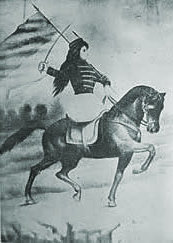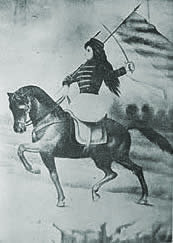
|
Women and Independence in Latin America An exploration of women's involvement in the Latin American Wars of Independence |

|

|
Women and Independence in Latin America An exploration of women's involvement in the Latin American Wars of Independence |

|
Gender:Male
Ethnic origen: White
Events:
| 1774 | - | Oaxaca | - | Not applicable | - | He was born on 4 November 1774 in Antequera de Oaxaca. |
| 1794 | - | Mexico City | - | Unknown | - | He began work as a lawyer here in 1794. |
| 1812 | - | Mexico | - | Patriot | - | He joined the independence cause. |
| 1814 | - | Zacatlán | - | Patriot | - | He fled to Zacatlán in 1814 |
| 1815 | - | Puebla (State) | - | Not applicable | - | He returned here from Zacatlán in 1815 |
| 1817-1820 | - | Veracruz | - | Patriot | - | He was imprisoned in Veracruz from 1817-1820. |
| 1820 | - | Mexico | - | Patriot | - | He became Santa Anna's secretary. |
| 1821 | - | Mexico | - | Unknown | - | He supported Iturbide. |
| 1822 | - | Mexico | - | Unknown | - | He conspired against Iturbide. |
| 1823 | - | Mexico City | - | Unknown | - | He was diputado in 1823. |
| 1829 | - | Mexico | - | Unknown | - | He is said to have written a petition in 1829 on behalf of 50 Mexican women married to Spaniards. |
| 1837-1841 | - | Mexico City | - | Unknown | - | He was a member of the conservative government from 1837-41. |
| 1844-1845 | - | Oaxaca | - | Unknown | - | He was elected as diputado for Oaxaca, 1844-45. |
| 1848 | - | Mexico City | - | Unknown | - | He died 21 September 1848. |
Connections:
Editors newspapers and magazinesBiography:
Born in Antequera de Oaxaca in 1774, he was an "outspoken liberal" who joined the independence cause in 1812, and supported Iturbide in 1821. He was imprisoned twice (after 1812 for his independence activities, and after 1821 for congressional activities). (Lynch, xiv)
A journalist and writer who supported Leona Vicario, and Mexican women whose husbands were expelled from the country following independence. He is said to have written a petition in 1829 on behalf of 50 Mexican women who objected to the expulsion of their husbands. (Arrom, 41-43)
He is described by Calderón de la Barca as having a literary reputation. He wrote Mornings in the Alameda, a textbook of Mexican history for girls. He sent the book to Calderón de la Barca and she commented, “I […] was struck with the liberality of his remarks in regard to the Spaniards, which, coming from such a source, are so much more valuable and worthy of credit than any that can be made by a foreigner.” She names him among Mexico’s “distinguished men” of literature. And adds, as a general comment, “nearly all these, at least those who are married, have had the good fortune to unite themselves with women who are either their equals or superiors, in not in education – in goodness, elevation of sentiment and natural talent”. It is possible that he attended Calderón de la Barca's tertulias. (Calderón de la Barca, 355, 357-358, 360)
He celebrated the indigenous past and stressed its continuity with the present. In 1813 he wrote the speech given by Morelos at the Chilpancingo Congress. (Brading, 306-307)
He began to work as a lawyer in Mexico City in 1794. He was editor of Diario de México in 1805 in which he stated his liberal ideas. He sympathised with Hidalgo and on 1812, under the Constitution of Cadiz, he published .El Juguetillo., an anti-colonial newspaper. He joined with Morelos in Oaxaca in 1812, and they fled to Zacatlán, Puebla, where he established a secretariat, and organised troops. The Viceroy offered him an amnesty, and when Bustamente refused it, the Viceroy ordered the arrest of his wife, Manuela García Villaseñor. She then fled to Zacatlán. They left Zacatlán in 1814 when it fell into royalist control and tried unsuccessfully to enter the United States. He was imprisoned in Veracruz from 1817-20. In 1820 he became Santa Anna's secretary. In 1821, he joined Iturbide's independence campaign, but was imprisoned again when he conspired against Iturbide in 1822. After Iturbide was deposed, he became a member of Congress as representative of Mexico City. He was part of the conservative government of 1837-41 and was elected as diputado for Oaxaca from 1844-1845. (Gueda, 171-172)
He was a mason, like Vicente Guerrero, belonging to the York Rite Grand Lodge India Azteca. (Racine, 539)
He was a member of the Sociedad de los Guadalupes. (Torre Villar, lxxvi)
In 1817 wrote outlining the contribution of his wife, Manuela García Villaseñor to the independence cause (see below). (Miquel i Vergés, 227)
He died in 1848.
References:
Lynch, John (editor). (1994) Latin American Revolutions
Werner, Michael S. (editor). (1997) Encyclopedia of Mexico
Arrom, Silvia Marina (1985) The women of Mexico City, 1790-1857
Calderón de la Barca, Frances (1982) Life in Mexico
Lynch, John (1986) The Spanish American Revolutions 1808-1826
Miquel i Vergés, José María (1969) Diccionario de Insurgentes
Rodríguez, Carlos (1963) Heroes de la Independencia
Torre Villar, Ernesto de la (1966) Los "Guadalupes" y la Independencia, con una selección de documentos inédittos